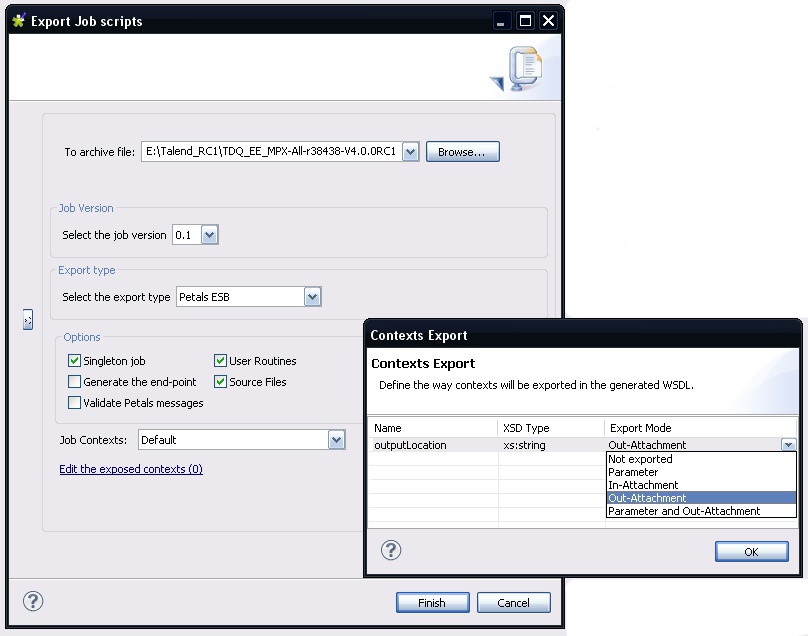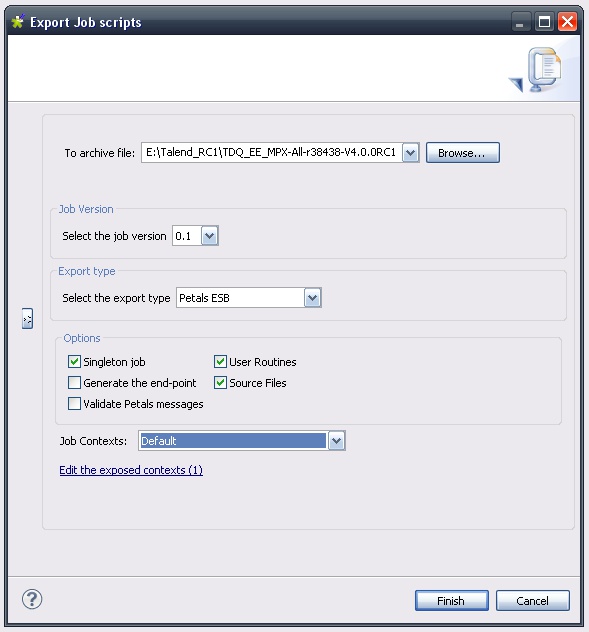Preliminary notes
This use case can only be reproduced with Talend Integration Suite.
This use case relies on the use case "A Simple Talend Job".
Rationale
Execute a Talend job into Petals, whose resulting file will be returned as an attachement.
The job is exposed as a service into Petals. When this service is called, it is executed. The file created by this job is then returned as an attchment.
The input message provides no information.
The response is made up of two parts:
- The job's result (an array of array of String).
- The created file, as an output attachment.
Creating and exporting the job
The job to be executed performs the following actions:
- The job connects to a database.
- It retrieves the content of a table.
- It serializes part of the extracted data as a CSV file on the disk.
- Once the execution terminated, the created file is attached to the returned message.
This job has one context variable, which indicates the location of the CSV file.
This location will be read by the Petals-SE-Talend component once the execution is terminated. The file will then be attached to the returned message.
 | In the scope of this use case, it is assumed there is a database formationtalend on the localhost, having a table named customers.
The schema of the customers table includes two columns named CustomerName and CustomerAddress, both being of type varchar(255). |
Creating the job
The job export is detailled in the use case "A Simple Talend Job".
There is no difference.
 | Just be careful to provide a default value to the outputLocation context variable. |
Exporting the job
Select the job and right-click it. Select Export Job Scripts.
In the Export type combo, select Petals ESB.
Update the target destination and let the job be exposed as a singleton.
Click Edit the exposed contexts.
A dialog shows up. Export the outputLocation context as an Out-Attachment.
You should have the following dialog:

Click the Export mode column, and select Parameter in the combo box. Click OK.
The link label should be updated and indicate the number of exported contexts.

Click Finish.
Deploying and testing in Petals
Looking at the generated WSDL
In the created Petals service assembly, the most interesting thing to look at is the WSDL.
Indeed, the WSDL will determine the way the exported service will be called.
The input message's description requires empty parameters.
<xs:element name="executeJob" type="tns:executeJob" />
<xs:complexType name="executeJob">
<xs:sequence>
<xs:element minOccurs="0" name="contexts" type="tns:talendContexts" />
<xs:element minOccurs="0" name="in-attachments" type="tns:inAttachments" />
<xs:element maxOccurs="unbounded" minOccurs="0" name="in-data-bean" type="tns:inRow" />
<xs:element maxOccurs="unbounded" minOccurs="0" name="talend-option" type="xs:string" />
</xs:sequence>
</xs:complexType>
<xs:complexType name="talendContexts">
<xs:sequence>
</xs:sequence>
</xs:complexType>
<xs:complexType name="inAttachments">
<xs:sequence>
</xs:sequence>
</xs:complexType>
<xs:complexType name="inRow">
<xs:sequence>
</xs:sequence>
</xs:complexType>
And the output message includes the job's result and the output attachment.
<xs:element name="executeJobResponse" type="tns:executeJobResponse" />
<xs:complexType name="executeJobResponse">
<xs:sequence>
<xs:element minOccurs="0" name="talend-job-output" type="tns:talendJobOutput" />
</xs:sequence>
</xs:complexType>
<xs:complexType name="talendJobOutput">
<xs:sequence>
<xs:element maxOccurs="unbounded" minOccurs="0" name="executionResult" nillable="true" type="ns1:stringArray" />
<xs:element minOccurs="0" name="outAttachment" type="tns:outAttachments" />
<xs:element maxOccurs="unbounded" minOccurs="0" name="outDataBean" nillable="true" type="tns:outRow" />
</xs:sequence>
</xs:complexType>
<xs:complexType name="outAttachments">
<xs:sequence>
<xs:element name="outputLocation" nillable="true" type="tns:attachment" />
</xs:sequence>
</xs:complexType>
<xs:complexType name="outRow">
<xs:sequence>
</xs:sequence>
</xs:complexType>
Deploying and testing this new service
Since we use attachments, we will prefer using a Java client instead of SoapUI.
However, it is possible to use SoapUI to send or receive messages with attachments. Just make sure the MTOM property is activated.
The first thing to do is to create a service-unit for the Petals-BC-SOAP component, that exposes (consumes) our Talend job as a service outside the bus.
This step is not described here. You can take a look at the Petals-BC-SOAP documentation and the Petals Studio documentation.
Just make sure the SOAP configuration uses the InOut MEP.
Then, to generate a client from the WSDL, you can use Apache CXF or Axis2.
As an example, the following code was generated with Apache CXF 2.2.6.
Check the CXF documentation to see how to develop a service consumer in Java.
Only the main client class is shown here.
The client's code is the following:
Notice that the MTOM-mode was activated. Not enabling it will result in errors.
The execution output is:
If the job execution fails, the 0 is replaced by another integer, e.g. 1.
One failure reason can be, as an example, that the database is not started.
To determine the act cause of a problem, you would have to use logging features available in the Talend palet.
However, let's make it clear, the job's logs are managed independently of Petals and its monitoring capabilities.
|